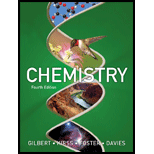
Concept explainers
Interpretation: The nitrogen oxides that have more than
Concept introduction: Molar mass of a compound is sum of the
To determine: The nitrogen that have more than
Answer to Problem 3.80QP
Solution
The compounds that have the same empirical formula are shown in Figure 1. The nitrogen oxides that have more than
Explanation of Solution
Explanation
Molecular mass of
Number of nitrogen atoms is
Number of oxygen atoms is
Molar mass of nitrogen is
Molar mass of oxygen is
Substitute the value of number of atoms and molar masses of nitrogen and oxygen in the above equation.
The percent composition of oxygen (O) in
Substitute the value of mass of O atoms and mass of
Therefore, the percent composition of oxygen in
Molecular mass of
Number of nitrogen atoms is
Number of oxygen atoms is
Molar mass of nitrogen is
Molar mass of oxygen is
Substitute the value of number of atoms and molar masses of nitrogen and oxygen in the above equation.
The percent composition of oxygen (O) in
Substitute the value of mass of O atoms and mass of
Therefore, the percent composition of oxygen in
Molecular mass of
Number of nitrogen atoms is
Number of oxygen atoms is
Molar mass of nitrogen is
Molar mass of oxygen is
Substitute the value of number of atoms and molar masses of nitrogen and oxygen in the above equation.
The percent composition of oxygen (O) in
Mass of
Substitute the value of mass of O atoms and mass of
Therefore, the percent composition of oxygen in
Molecular mass of
Number of nitrogen atoms is
Number of oxygen atoms is
Molar mass of nitrogen is
Molar mass of oxygen is
Substitute the value of number of atoms and molar masses of nitrogen and oxygen in the above equation.
The percent composition of oxygen (O) in
Mass of
Substitute the value of mass of O atoms and mass of
Therefore, the percent composition of oxygen in
Molecular mass of
Number of nitrogen atoms is
Number of oxygen atoms is
Molar mass of nitrogen is
Molar mass of oxygen is
Substitute the value of number of atoms and molar masses of nitrogen and oxygen in the above equation.
The percent composition of oxygen (O) in
Mass of
Substitute the value of mass of O atoms and mass of
Therefore, the percent composition of oxygen in
Molecular mass of
Number of nitrogen atoms is
Number of oxygen atoms is
Molar mass of nitrogen is
Molar mass of oxygen is
Substitute the value of number of atoms and molar masses of nitrogen and oxygen in the above equation.
The percent composition of oxygen (O) in
Mass of
Substitute the value of mass of O atoms and mass of
Therefore, the percent composition of oxygen in
The nitrogen oxides that have more than
The ratio of
The ratio of
Conclusion
The nitrogen oxides that have more than
Want to see more full solutions like this?
Chapter 3 Solutions
Chemistry
- (f) SO: Best Lewis Structure 3 e group geometry:_ shape/molecular geometry:, (g) CF2CF2 Best Lewis Structure polarity: e group arrangement:_ shape/molecular geometry: (h) (NH4)2SO4 Best Lewis Structure polarity: e group arrangement: shape/molecular geometry: polarity: Sketch (with angles): Sketch (with angles): Sketch (with angles):arrow_forward1. Problem Set 3b Chem 141 For each of the following compounds draw the BEST Lewis Structure then sketch the molecule (showing bond angles). Identify (i) electron group geometry (ii) shape around EACH central atom (iii) whether the molecule is polar or non-polar (iv) (a) SeF4 Best Lewis Structure e group arrangement:_ shape/molecular geometry: polarity: (b) AsOBr3 Best Lewis Structure e group arrangement:_ shape/molecular geometry: polarity: Sketch (with angles): Sketch (with angles):arrow_forward(c) SOCI Best Lewis Structure 2 e group arrangement: shape/molecular geometry:_ (d) PCls Best Lewis Structure polarity: e group geometry:_ shape/molecular geometry:_ (e) Ba(BrO2): Best Lewis Structure polarity: e group arrangement: shape/molecular geometry: polarity: Sketch (with angles): Sketch (with angles): Sketch (with angles):arrow_forward
 ChemistryChemistryISBN:9781305957404Author:Steven S. Zumdahl, Susan A. Zumdahl, Donald J. DeCostePublisher:Cengage Learning
ChemistryChemistryISBN:9781305957404Author:Steven S. Zumdahl, Susan A. Zumdahl, Donald J. DeCostePublisher:Cengage Learning ChemistryChemistryISBN:9781259911156Author:Raymond Chang Dr., Jason Overby ProfessorPublisher:McGraw-Hill Education
ChemistryChemistryISBN:9781259911156Author:Raymond Chang Dr., Jason Overby ProfessorPublisher:McGraw-Hill Education Principles of Instrumental AnalysisChemistryISBN:9781305577213Author:Douglas A. Skoog, F. James Holler, Stanley R. CrouchPublisher:Cengage Learning
Principles of Instrumental AnalysisChemistryISBN:9781305577213Author:Douglas A. Skoog, F. James Holler, Stanley R. CrouchPublisher:Cengage Learning Organic ChemistryChemistryISBN:9780078021558Author:Janice Gorzynski Smith Dr.Publisher:McGraw-Hill Education
Organic ChemistryChemistryISBN:9780078021558Author:Janice Gorzynski Smith Dr.Publisher:McGraw-Hill Education Chemistry: Principles and ReactionsChemistryISBN:9781305079373Author:William L. Masterton, Cecile N. HurleyPublisher:Cengage Learning
Chemistry: Principles and ReactionsChemistryISBN:9781305079373Author:William L. Masterton, Cecile N. HurleyPublisher:Cengage Learning Elementary Principles of Chemical Processes, Bind...ChemistryISBN:9781118431221Author:Richard M. Felder, Ronald W. Rousseau, Lisa G. BullardPublisher:WILEY
Elementary Principles of Chemical Processes, Bind...ChemistryISBN:9781118431221Author:Richard M. Felder, Ronald W. Rousseau, Lisa G. BullardPublisher:WILEY





